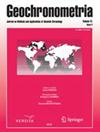Luminescence Characteristics of Intraplate-Derived Olivines
IF 0.9
4区 地球科学
Q3 Earth and Planetary Sciences
引用次数: 0
Abstract
Abstract Olivine has so far attracted limited attention as a potential luminescence dosimeter. In particular, there is a dearth of information concerning the luminescence properties of geochemically characterised, pure olivine samples. Six well-characterised olivine samples from four intraplate settings are investigated in this study, including emission wavelengths and intensities, growth of signal with absorbed dose, signal stability and recovery of a given dose with a single aliquot regeneration (SAR) protocol. All tested olivines share a low-temperature (90–100°C) UV/blue thermoluminescence (TL) peak, and five of six samples also produce a low-temperature red/yellow emission. Higher temperature TL peaks, which would be thermally stable over geological timescales and could be used for dating, are rarely observed at low doses (c. 46 Gy), but detectable though dim at significantly higher doses (c. 460 Gy). Photostimulated luminescence (PSL) emissions are very dim, but reliably detected emissions are stimulated by blue, yellow and infrared (IR) light. PSL yielded generally successful dose recovery results; however, all tested signals are prone to significant anomalous fading and complex thermal transfer between unbleachable and bleachable traps. These characteristics must be addressed if olivine is to be used as a natural dosimeter for luminescence dating. Given the variety of luminescence responses, it appears that olivine samples in future dating work may need to be individually characterised prior to measurement.板内衍生橄榄石的发光特性
摘要Olivine作为一种潜在的发光剂量计,迄今为止受到的关注有限。特别是,缺乏关于具有地球化学特征的纯橄榄石样品的发光特性的信息。本研究研究研究了来自四种板内环境的六个表征良好的橄榄石样品,包括发射波长和强度、吸收剂量下信号的生长、信号稳定性以及单等分试样再生(SAR)方案下给定剂量的回收。所有测试的橄榄石都有一个低温(90–100°C)紫外/蓝色热释光(TL)峰,六个样品中有五个也产生低温红/黄发射。高温TL峰在地质时间尺度上是热稳定的,可用于年代测定,在低剂量(约46 Gy)下很少观察到,但在明显较高的剂量(约460 Gy)时可以检测到,尽管很微弱。光刺激发光(PSL)发射非常微弱,但可靠检测到的发射是由蓝色、黄色和红外(IR)光刺激的。PSL产生了普遍成功的剂量回收结果;然而,所有测试的信号都容易出现显著的异常衰落以及不可漂白和可漂白陷阱之间的复杂热传递。如果橄榄石要用作发光测年的天然剂量计,就必须解决这些特性。鉴于发光响应的多样性,在未来的测年工作中,橄榄石样品似乎需要在测量之前进行单独表征。
本文章由计算机程序翻译,如有差异,请以英文原文为准。
求助全文
约1分钟内获得全文
求助全文
来源期刊

Geochronometria
地学-地球科学综合
CiteScore
2.20
自引率
0.00%
发文量
1
审稿时长
>12 weeks
期刊介绍:
Geochronometria is aimed at integrating scientists developing different methods of absolute chronology and using them in different fields of earth and other natural sciences and archaeology. The methods in use are e.g. radiocarbon, stable isotopes, isotopes of natural decay series, optically stimulated luminescence, thermoluminescence, EPR/ESR, dendrochronology, varve chronology. The journal publishes papers that are devoted to developing the dating methods as well as studies concentrating on their applications in geology, palaeoclimatology, palaeobiology, palaeohydrology, geocgraphy and archaeology etc.
 求助内容:
求助内容: 应助结果提醒方式:
应助结果提醒方式:


